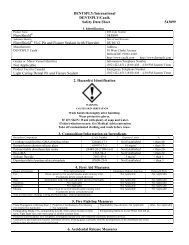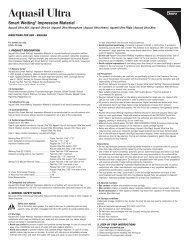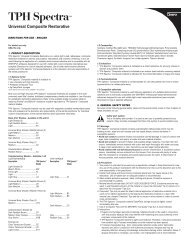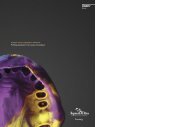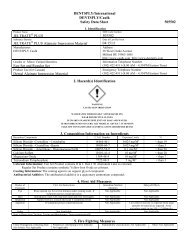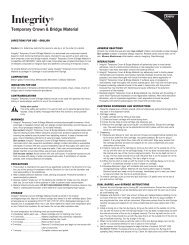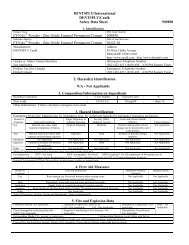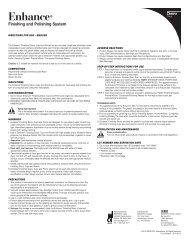Indirect and Direct Restorative Protocols - Caulk
Indirect and Direct Restorative Protocols - Caulk
Indirect and Direct Restorative Protocols - Caulk
You also want an ePaper? Increase the reach of your titles
YUMPU automatically turns print PDFs into web optimized ePapers that Google loves.
››Principles & Practices<br />
Predictable<br />
Tissue Retraction:<br />
Methods <strong>and</strong> Techniques<br />
››Abstract:<br />
Accurate data transfer<br />
between the clinician <strong>and</strong><br />
ceramist is critical for any<br />
indirect restorative procedure.<br />
A precise retraction technique<br />
is necessary to allow for<br />
reliable information transfer<br />
during impression making.<br />
Since different surfaces<br />
(eg, gingival tissues, dentin,<br />
enamels, <strong>and</strong> metals) have<br />
such varied moisture content,<br />
friction resistance, <strong>and</strong> surface<br />
tensions, clinicians should also<br />
use a reliable methodology<br />
in which each surface can be<br />
predictably optimized prior to<br />
impressing for the best<br />
possible results.<br />
S<br />
uccessful placement of a fixed<br />
dental prosthesis requires the<br />
clinician to accurately communicate<br />
the details of the patient’s<br />
intraoral environment to<br />
the laboratory technician. To capture this<br />
information, the practitioner must first<br />
control systemic factors (eg, periodontal<br />
health, crevicular fluid, inflammation) at<br />
the restorative site, create a proper margin<br />
design, <strong>and</strong> then make an impression of<br />
the required preparation. Additionally, he<br />
or she must displace or remove the gingival<br />
tissues that prevent the subsequently<br />
applied impression material from gaining<br />
access to a subgingival finish line.<br />
Care should, therefore, be taken to utilize<br />
proper methods of exposing subgingival<br />
finish line <strong>and</strong> to select a retraction cord<br />
that is resistant to fraying or tearing <strong>and</strong> that<br />
will not adhere to the dental tissues or the<br />
impression material. Although some cords<br />
are available in a pre-impregnated format to<br />
assist in hemostasis, it is generally advisable<br />
to utilize a hemostatic agent in order to limit<br />
the presence of fluids during impression<br />
capture <strong>and</strong> to ensure a clear, detailed margin<br />
(Figure 1). Localized anesthesia may be<br />
indicated for patients who require it, <strong>and</strong><br />
can be applied to one or several periodontal<br />
pockets in a needle-free application.<br />
Retraction Cords <strong>and</strong> Pastes<br />
When employing retraction devices, the<br />
primary concern is maintenance of clear<br />
finish lines <strong>and</strong> margins in order to ensure<br />
their capture <strong>and</strong> transfer to a detailed impression.<br />
Whether using a cord or paste retraction<br />
material (Table), proper packing<br />
also allows the impression material to flow<br />
subgingivally, which enables the soft tissue<br />
topography <strong>and</strong> prepared hard tissues<br />
to be properly recorded (Figure 2). When<br />
using retraction cord techniques, the clinician<br />
should:<br />
■■<br />
Create a lateral space of >0.5 mm;<br />
■■ Take care when using a heavy/rigid<br />
tray material to avoid locking an<br />
impression in undercuts;<br />
■■ Delay the impression procedure if<br />
adequate hemostasis cannot be<br />
achieved; <strong>and</strong><br />
■■ Maintain proper moisture control<br />
subgingivally.<br />
Figure 1. The retraction cord should be placed carefully to avoid soft<br />
tissue trauma <strong>and</strong> ensure precise marginal detail in the impression.<br />
Figure 2. Correct positioning of the retraction cord should be verified<br />
prior to impression making.<br />
9



